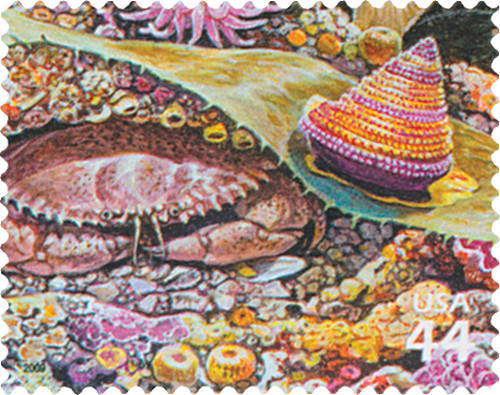
# 4423h - 2009 44c Kelp Forest: Rock Crab and Jeweled Top Snail
Kelp Forest – Jeweled Top Snail
Nature of America
Issue Date: October 1, 2009
City: Monterey, CA
With its vibrant purple and gold bands, the jeweled top snail would look as natural on a woman’s ring as it does on kelp.
Living and feeding primarily on kelp, the jeweled top shares the seaweed with other snail species. Each variety knows its proper place on the kelp, and if one falls off, it will climb back up to its assigned spot.
The jeweled top snail has two sets of tentacles. One contains light-sensitive eyespots at the base for sight, while the second is for smell and touch. The dazzling shell that houses the snail is covered in a layer of mucus, which makes it difficult for possible predators to hold onto the shell.
The jeweled top snail feeds on both plants and animals. Because its jaws are poorly developed, it was once thought to be primarily a scavenger. This was until 1975, when a jeweled top snail was observed attacking an anemone. Rearing up on its back feet, the snail pulled back its lips and lunged at the anemone, biting one of its tentacles.
The jeweled top snail also feeds on copepods, which are parasites that attach to other marine animals. By eliminating copepods, the snail helps preserve the health of the kelp forest.
Kelp Forest – Jeweled Top Snail
Nature of America
Issue Date: October 1, 2009
City: Monterey, CA
With its vibrant purple and gold bands, the jeweled top snail would look as natural on a woman’s ring as it does on kelp.
Living and feeding primarily on kelp, the jeweled top shares the seaweed with other snail species. Each variety knows its proper place on the kelp, and if one falls off, it will climb back up to its assigned spot.
The jeweled top snail has two sets of tentacles. One contains light-sensitive eyespots at the base for sight, while the second is for smell and touch. The dazzling shell that houses the snail is covered in a layer of mucus, which makes it difficult for possible predators to hold onto the shell.
The jeweled top snail feeds on both plants and animals. Because its jaws are poorly developed, it was once thought to be primarily a scavenger. This was until 1975, when a jeweled top snail was observed attacking an anemone. Rearing up on its back feet, the snail pulled back its lips and lunged at the anemone, biting one of its tentacles.
The jeweled top snail also feeds on copepods, which are parasites that attach to other marine animals. By eliminating copepods, the snail helps preserve the health of the kelp forest.








